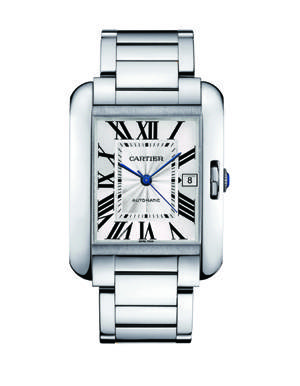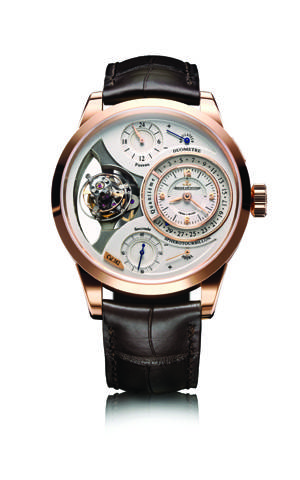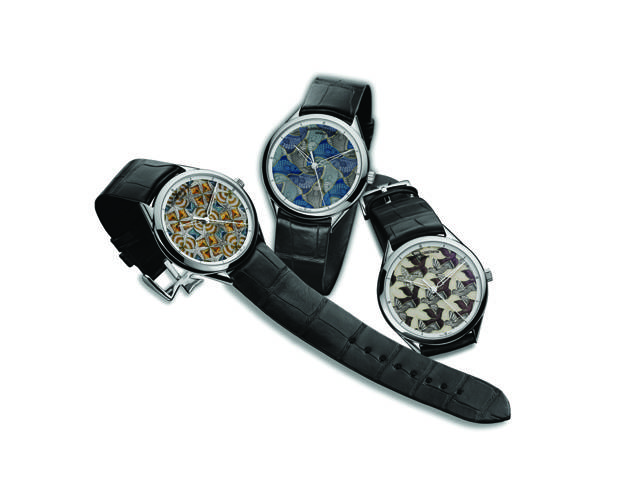Tanks For The Memories: The Cartier Tank Anglaise
Price: $41,600
First introduced in 1918, there’s no doubt that the Cartier Tank is one of the most imitated watches in the world. Legend has it that the first Tank watch was a prototype, designed by Louis Cartier and inspired by the profile of the first tanks used by the Allied powers in the First World War.The brancards allowed the Tank watch to assume a dramatic, geometric shape which up until then hadn’t been seen in watchmaking, and which made it an icon of early Art Deco design.
The tale of the Tank’s origins say that the first prototype was given to General Pershing in 1918, but what we do know is that the first Tank was introduced commercially in 1919. Though the shape has been imitated by other manufacturers ad nauseam, for much of its history, the Tank was an extremely rare and very exclusive watch. From its introduction up until 1960, less than 100 Tank watches were made per year. The Tank has also been, for Cartier, a template for an enormous number of variations and Tank watch scholarship alone could keep a dedicated collector busy for a lifetime. Despite the plethora of variations, Cartier’s inventiveness continues to produce new models and this year at the Salon International de la Haute Horlogerie, debuted the newest Tank model: the Tank Anglaise.
The Tank Anglaise joins the Tank Americaine and the Tank Francaise in a trio of watches named to honor the London, New York and Paris locations of Cartier’s three flagship boutiques. The Tank Anglaise is a further development of the inspiration behind the original Tank of 1919. That watch was unusual in taking the then-radical step of making the case flanks and the point of attachment for the strap a single design element. The Tank Anglaise goes one step further and encloses the winding crown –the single protruding element in the original Tank design –entirely in the brancard that forms the flank of the case, creating a smooth silhouette only slightly interrupted by the blue sapphire cabochon. In some respects, it’s the purest Tank yet –a sleekly elegant extension of the original design and a clear indication that even in the quest for simplicity, the story of the Tank rolls on.
The large model Tank Anglaise is shown in white gold with a white gold bracelet and in-house automatic calibre 1904 MC.
Racing Heart: The Montblanc Timewriter Ii Chronographe Bi-Fréquence 1,000
Price: $305,900
If you’re a regular Haute Time reader, you know that some of the biggest innovations recently are in the development of chronographs capable of measuring ever-smaller fractions of a second. The current record-holder, from TAG Heuer, is the Mikrogirder 2000 but another concept watch took the stage at the Salon International Haute Horlogerie using only mechanical solutions.
The Montblanc Timewriter II Chronographe Bi-Fréquence 1,000 is capable of measuring intervals of time as small as 1/1000 of a second. While its precision is less than that of the Mikrogirder, it’s still far greater than virtually any other chronograph in production. For a chronograph, the smallest division of a second that can be measured equals the frequency of the oscillator –so, for a watch to measure intervals of time as small as 1/10th of a second it’s necessary for the oscillator that controls the watch to beat 10 times per second. The faster a watch ticks, the shorter an interval of time it can measure.
The Chronograph Bi-Fréquence is the brainchild of watchmaker Bartomeu Gomila who has worked extensively as a restorer of vintage watches and clocks.The problem he faced was how to make a chronograph capable of intervals of 1/1000 of a second when a balance spring and balance combo is not capable of beating so quickly.
His solution was to construct the chronograph mechanism around a second oscillator beating 100 times per second. Gomila’s new use of a gearing system to drive a continuously rotating wheel, which turns ten times per second, allowed its rotation to be subdivided into even shorter intervals than 1/100th of a second.
The Montblanc Timewriter II Bi- Fréquence will be produced in a limited edition of 36 pieces, in white gold.
Revolution In Time: The Jaeger Le Coultre Duométre A Sphérotourbillon
Price: $262,000
One of the most talked about watches at the Salon International Haute Horlogerie in Geneva was the Jaeger LeCoultre Sphérotourbillon. The basic idea behind the Dual Wing watches is to have two independent power sources. One main spring powers the timekeeping gear train and the other is used to supply energy to the complication. The reason behind this construction is a complication has the potential to disrupt the accuracy of a watch by stealing energy, when it’s in use, from the escapement, which requires as much constant torque as possible to work well.
The solution in traditional watchmaking is to exercise great care in the construction of the complication, so as to reduce the amount that torque varies when the complication is running. Jaeger LeCoultre has opted for another solution –one which has allowed them to incorporate several useful features into the Sphérotourbillon.
The Sphérotourbillon is, as is obvious from the name, a tourbillon wristwatch. Tourbillons, however, were invented over 200 years ago when wristwatches were still over a century in the future, and what works in a pocket watch works less well in a wristwatch. To address this problem, the multiple axis tourbillon was developed. Originally pioneered by English watchmakers Randall and Good, multi-axis tourbillons are very rare, with notable models made by independent watchmaker Thomas Prescher and by Greubel Forsey, which made the first inclined multi-axis tourbillon wristwatches, in which the central axis of the tourbillon is tilted relative to the watch in order to further reduce the chances of the escapement. Jaeger LeCoultre is no stranger to multiaxis tourbillons itself, having made the Gyrotourbillon I and II, both of which feature a double tourbillon cage.
The Sphérotourbillon is the first inclined, dual-axis tourbillon produced by Jaeger LeCoultre and also the first JLC tourbillon to use the Dual Wing system. The tourbillon is an exotic. There are two cages –the inner rotates once every 30 seconds, and the outer once every 15 seconds. The tourbillon is inclined at a 20 degree angle and the balance spring is cylindrical –a rare shape, usually reserved for use only in ship’s chronometers.
The fact that there are two separate power supplies also allowed Jaeger LeCoultre to solve a longstanding problem in tourbillons, which is that despite their declared purpose of improving accuracy, it’s impossible to set most to the nearest second. A pusher built into the Sphérotourbillon’s case instantly re-sets the seconds hand to zero, allowing it to be coordinated with an external time reference without stopping the watch from running, which is possible because there are two independent power sources.
All is delivered in a classic chassis –the Sphérotourbillon despite its complexity and the inherently large size of the tourbillon mechanism, is only 42mm in diameter and a svelte 14.1mm thick. For real connoisseurs of the pursuit of greater accuracy in mechanical watches and horological rarity, the Sphérotourbillon is magic in motion.
The Jaeger Sphérotourbillon is only available in red gold and in addition to the tourbillon, features a date and second time zone display, as well as power reserve indications for each power source.
Spacetime Continuum: M. C. Escher And The Vacheron Constantin “Les Univers Infinis” Watches
Price: Brown $112,000 , Coffee $120,000
The remarkable work of Dutch artist M. C. Escher has been a subject of fascination for art lovers and mathematicians alike for many decades. Escher’s work draws on a number of phenomena, including the use of stylized figures which, repeated over and over, interlock to form patterns of tessellations, as well as the use of images which exploit the cognitive predispositions of the human nervous system to produce distinctly un-nerving effects, such as the apparently impossible infinite loop of staircases in one of his most famous images, the etching “Relativity,” of 1953.
Escher’s work occupies a unique niche in the history of art and is a special instance of how a particular vision can cross many disciplines to produce spectacular and unprecedented artistic effects. It is surprising that it has taken so long for his motifs to be incorporated into a watch. Mechanical watches, after all, represent another unique intersection of métiers, requiring engineering and scientific knowledge, but also a genuinely artistic sensibility and, like Escher’s work are not mere instruments but also expressions of a particular vision of what time is and how we experience its passage.
At this year’s Salon International Haute Horlogerie, Vacheron Constantin introduced three remarkably beautiful new watches to its Metiers d’Art collection. The new watches are a trilogy –three sets of 20 watches each, whose dials are decorated with a motif taken from the work of Escher. They are collectively known as the “Les Univers Infinis” watches.
The three motifs are a pattern of doves, a pattern of fish, and a pattern of seashells and starfish, executed with a range of engraving, gemsetting and guilloché techniques which produce an absorbing range of visual effects. The Fish watch incorporates guilloché and cloisonné enameling; the Dove watch, guilloché, champlevé enameling, and gem-setting; and the Shell watch, engraving and champlevé enameling.
Fired enamel decoration is produced by grinding colored glass into a fine powder and mixing it with a medium like water or oil. It is then placed into engraved hollows in a metal surface or into cells made by bending gold wire into the desired form using a fine sable brush. The enamel is then placed in a kiln and fired to a temperature close to 1,000 degrees Celsius Repeated firings are often necessary and the process is perilous, as even microscopic impurities can ruin the enamel. True fired enamel watch dials are extremely rare, ardently collected and very valuable.
Inside the Les Univers Infinis watches is another work of art: the Vacheron Constantin self-winding calibre 2460 SC. Each timepiece is one of the most beautiful expressions of a vision of time and its relationship to space that we’ve ever seen in watchmaking.




























